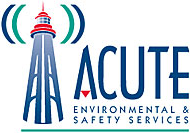
For employees and employers alike, there are few things more important than worker health and safety. One area not to be overlooked is fatigue, which can have adverse effects on the mind, body, and overall productivity. Proper health and safety training can help keep workers safe from all possible hazards, including fatigue. With over 100 years of combined experience, you can trust ACUTE for all your safety training needs.
Worker Health and Safety: Fatigue Matters
What is Fatigue?
We’ve all felt it, but do we all know how to define fatigue?
Canada’s National Centre for Occupational Health and Safety defines regular fatigue as the following:
Fatigue is the state of feeling very tired, weary or sleepy resulting from insufficient sleep, prolonged mental or physical work, or extended periods of stress or anxiety. Boring or repetitive tasks can intensify feelings of fatigue. Fatigue can be described as either acute or chronic.
To expand, acute fatigue “results from short-term sleep loss or from short periods of heavy physical or mental work. The effects of acute fatigue are of short duration and can generally be reversed by sleep and relaxation.” Chronic fatigue syndrome is “the constant, severe state of tiredness that is not relieved by rest. The symptoms of chronic fatigue syndrome are similar to the flu, last longer than six months, and interfere with certain activities. The exact cause of this syndrome is still unknown” (source).
Work-related factors may include long work hours, long periods of physical or mental activity, insufficient break time between shifts, changes to jobs or shift rotations, inadequate rest, excessive stress, having multiple jobs, or any combination of these factors.
All of the above can be further exacerbated by home situations that do not allow for proper rest and relaxation.
Remember: Studies show that we need at least 7 to 9 hours of sleep every day, and most night workers get about 5 to 7 hours less sleep per week than those working the day shift.

How is Fatigue a Concern for Worker Health and Safety?
Fatigue is most certainly a worker health and safety issue, as in both its acute and chronic forms it is considered to be a form of impairment.
CCOHS states research has shown that the number of hours awake can be similar to blood alcohol levels. One study reports the following:
- 17 hours awake is equivalent to a blood alcohol content of 0.05
- 21 hours awake is equivalent to a blood alcohol content of 0.08 (the legal limit in Canada)
- 24-25 hours awake is equivalent to a blood alcohol content of 0.10
Additionally, some studies have shown that when workers have slept for less than 5 hours before work, or when workers have been awake for more than 16 hours, their chances of making mistakes at work due to fatigue are significantly increased.
The problem is that fatigue levels are not easily measured or quantified, meaning it’s difficult to isolate the impact of fatigue on accident and injury rates.
What we do know is that certain times of day are more conducive to accidents or injuries caused by fatigue. The Government of Alberta reports that most incidents occur when workers are more likely to want sleep – between midnight and 6 am, and between 1 to 3 pm.

Fatigue affects people differently, but it can affect worker health and safety in several ways:
- reduced decision-making ability,
- reduced ability to do complex planning,
- reduced communication skills,
- reduced productivity or performance,
- reduced attention and vigilance,
- reduced ability to handle stress on the job,
- reduced reaction time – both in speed and thought,
- loss of memory or the ability to recall details,
- failure to respond to changes in surroundings or information provided,
- inability to stay awake (e.g., falling asleep while operating machinery or driving a vehicle),
- increased tendency for risk-taking,
- increased forgetfulness,
- increased errors in judgement,
- increased sick time, absenteeism, rate of turnover,
- increased medical costs,
- increased incident rates.
(source)
All of the above can result in accidents, injuries, mistakes, and even death.
As such, it behooves everyone involved to ensure fatigue is as much of a non-issue as possible.
How to Combat Workplace Fatigue
Employers have a responsibility of providing manageable tasks, a safe work environment, and sufficient breaks during one’s shift.
It’s incumbent on employees to get proper rest while off the job. There is no one way to get a good sleep – what works for one person may not work for another. In general, CCOHS suggestions include:
- Go to bed and get up at the same time every day.
- Exercise regularly.
- Eat at regular intervals and consume a balanced diet.
- Use your bed primarily just for sleeping (e.g., do not watch television, read, or do work in bed).
- If you are not tired, do not try to force sleep. Get up and read or do something quiet instead.
- Avoid caffeine, tobacco, or alcohol before bedtime.
- Turn off your mobile devices.
- Make the room as dark and quiet as possible. Soundproof the room where possible or use earplugs.
- Most people sleep better when the room is cool. Consider using an air conditioner or fan in the summer months.
It can be a challenge to fit in 7-9 hours of solid sleep, but incorporating some of these strategies should help, thereby keeping you safer on the job.
Other fatigue risk management systems can be found here.

Why Choose ACUTE?
Trust ACUTE for a range of health and safety training programs; with over 100 years of combined experience, our staff have much more than just theoretical teaching to offer. We have first-hand experience in a variety of workplace situations which allows us to offer the same high-quality training classes across a broad range of subjects.
ACUTE’s president and co-owner Ron Campbell says, “At the end of the day we want to make sure our clients go home safe and sound to their families. That’s what we do”.
“We have used Acute Environmental & Safety Services Inc. for many years and our personnel always come back well trained, energized and bringing lots of ideas. They are provided with substantial and in-depth knowledge together with challenging opportunities to put into practice what they have learned into our field operations.”
– Dante, Environmental Service Company
Sources:
http://www.safetyandhealthmagazine.com/articles/15271-fatigue-and-worker-safety
https://www.ccohs.ca/oshanswers/psychosocial/fatigue.html



